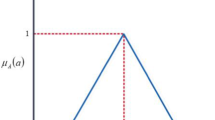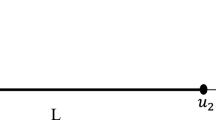Abstract
The motivation of this paper is to improve the accuracy of modal test for large-scale curved space structure, which we propose a kind of quasi-zero-stiffness (QZS) supporting method and develop a multiple-span circle curved beam model supported by geometrical nonlinear system applied in the complicated dynamical analysis. The QZS system is applied in the dynamic analysis for the circle antenna seemed as a multiple-span circle curved beam, for which the equivalent material parameters and the governing equation are obtained by energy equivalent method and Hamilton’s principle, respectively. Meanwhile, the theoretical modal analysis is carried out by applying transformation matrix method from order 1 to 4 with different supporting parameters, showing that the results obtained from QZS supports are more consistent with the free-constraint condition than linear supports with a weaker influence of supporting stiffness on the modal results. Moreover, the forced vibration and complicated dynamic behaviors are also taken into consideration by the averaging method and the fourth-order Runge–Kutta method, which indicated the system will vibrate in a chaotic state through the process double-periodical and quasi-periodical state, and the first two modalities will enter in the vibrating state with the same periodicity, which has a wider vibrating range for modal 1 than modal 2. Finally, the dynamic model of the circle truss is verified by the finite element method (FEM) in Ansys 2021, explaining the correctness of the dynamic model. The results in this paper indicate more ideal characteristics of the proposed quasi-zero-stiffness supporting method of modal test for the large-scale circle truss than linear elastic methods, especially in low-order modalities, which can obtain consistent modal results between ground tests and its space missions, providing a reference for engineering application.





















Similar content being viewed by others
References
Cao Q, Xiong Y, Wiercigroch M (2013) A novel model of dipteran flight mechanism. Int J Dynam Control 1:1–11
Chen G, Wu Z, Gong C et al. (2020) DIC-based operational modal analysis of bridges. Adv Civil Eng 39:1–13
Chen J, Zhang W, Zhang Y (2020) Equivalent continuum model and nonlinear breathing vibrations of rotating circular truss antenna subjected to thermal excitation. Thin-Walled Struct 157:107127
Coppotelli G, Grappasonni C, Di Trapani C (2013) Operational modal analysis of a solid rocket motor from firing test. J Spacecr Rocket 50:632–640
Feng S, H Y, Wen Y (2017) Application of Free Interface Modal Synthesis Method on Modal Test Boundary Transformation of One Missile,2017 3rd International Conference on Applied Mechanics and Mechanical Automation,2017: 57-61
Habaka M, Farag S, Khalil M et al. (2020) Experimental and computational dynamic structural analysis of free-flight rockets, IOP conference series. Mater Sci Eng 973:1–7
Han B, Xu Y, Yao J et al. (2019) Design and analysis of a scissors double-ring truss deployable mechanism for space antenna. Aerosp Sci Technol 93:1–10
Hao Z, Cao Q (2014) A novel dynamical model for GVT nonlinear supporting system with stable-quasi-zero-stiffness. J Theor Appl Mech 52:199–213
He S, Tang T, Xu E et al. (2020) Vibration control analysis of vehicle steering system based on combination of finite-element analysis and modal testing. J Vib Control 26:88–101
Jacobs S, Coconnier C, DiMaio D (2012) Deployable auxetic shape memory alloy cellular antenna demonstrator: design, manufacturing and modal testing. Smart Mater Struct 21:1–12
Liu M, Cao D (2020) Equivalent dynamic model of the space antenna truss. AIAA J 58:1851–1863
Liu M, Cao D, Li J et al. (2022) Dynamic modeling and vibration control of a large flexible space truss. Meccanica 57:1017–1033
Liu M, Cao D, Zhang X et al. (2020) Nonlinear dynamic responses of beamlike truss based on the equivalent nonlinear beam model. Int J Mech Sci 194:1–14
Liu M, Cao D, Zhu D (2021) Coupled vibration analysis for equivalent dynamic model of the space antenna truss. Appl Math Model 89:285–298
Liu G, Chen G, Cui F (2021) Nonlinear dynamic analysis of ring truss antenna equivalent to the cylindrical shell with thermal excitation. Eur J Mech / A Solids 85:1–18
Liu Y, Li X, Qian Y (2022) Rigid-flexible coupled dynamic and control for thermally induced vibration and attitude motion of a spacecraft with hoop-truss antenna. Appl Sci 12:1–20
Liu L, Shan J, Zhang Y (2016) Dynamics modeling and analysis of spacecraft with large deployable hoop-truss antenna. J Spacecr Rocket 53:471–479
Liu T, Zhang W (2017) Nonlinear dynamics of composite laminated circular cylindrical shell clamped along a generatrix and with membranes at both ends. Nonlinear Dyn 90:1393–1417
Lu W, Du X, Zeng C (2017) Application of Hammering Method Modal Testing in Larger Structure 2017 International Conference on Computer Systems, Electronics and Control, 2017: 188-192
Ma Z, Ding Q, Tang Y (2020) Operational modal analysis of a liquid-filled cylindrical structure with decreasing filling mass by multivariate stochastic parameter evolution methods. Int J Mech Sci 172:105420
Ma G, Xu M, Dong L (2021) Multi-point suspension design and stability analysis of a scaled hoop truss antenna structure. Int J Struct Stab Dyn 21:2150077
Martin B, Salehian A (2016) Mass and stiffness effects of harnessing cables on structural dynamics: continuum modeling. AIAA J 54:2881–2904
Noor A, Anderson M, Green W (1978) Continuum models for beam and plate-like lattice structure. AIAA J 12:1219–1228
Noor A, Nemeth M (1980) Analysis of spatial beamlike lattices with rigid joint. Comput Methods Appl Mech Eng 1:35–59
Noor A, Russell W (1986) Anisotropic continuum models for beam like lattice trusses. Comput Methods Appl Mech Eng 3:257–277
Pandit JK, Mahapatra DR, Pandiyan R (2016) Modal analysis of power electronics module of spacecraft and its health monitoring-an approach. Proc Eng 144:283–288
Salehian A, Chen Y (2012) On strain-rate dependence of kinetic energy in homogenization approach: theory and experiment. AIAA J 10:2029–2033
Salehian A, Ibrahim M, Seigler TM (2014) Damping in periodic structures: a continuum modeling approach. AIAA J 52:569–590
Salehian A, Inman D (2008) Dynamic analysis of a lattice structure by homogenization: experimental validation. J Sound Vib 316:180–197
Shen Z, Li H, Liu X et al. (2019) Thermal-structural dynamic analysis of a satellite antenna with the cable-network and hoop-truss supports. J Therm Stresses 42:1339–1356
Sirigulenga B, Zhang W, Liu T (2020) Vibration modal experiments and modal interactions of a large space deployable antenna with carbon fiber material and ring-truss structure. Eng Struct 207:1–13
Sun Y, Zhang W, Yao M (2017) Multi-pulse chaotic dynamics of circular mesh antenna with 1: 2 internal resonances. Int J Appl Mech 9:1–38
Wang H, Zhao J, Xue Y (2022) Application of Stewart platform in the low-frequency vibration characteristic test of space truss deployable antenna on satellite. Int J Aerospace Eng 2022:1–8
Wickramasinghe V, Chen Y, Zimcik D et al. (2013) Modal survey test and model correlation of the CASSIOPE spacecraft. Exp Tech 37:15–23
Wu R, Zhang W, Chen J (2022) Dynamic modeling and analytical global mode shapes of a folded beam-ring structure for a truss antenna reflector with two arms. Appl Math Model 110:542–561
Xia J, Song H (2017) Modal parameter identification of structure under base excitation using vibration test data. Proceed Inst Mech Eng, Part G: J Aerospace Eng 231:1428–1450
Yang T, Cao Q, Hao Z (2021) A novel nonlinear mechanical oscillator and its application in vibration isolation and energy harvesting. Mech Syst Signal Process 155:1–20
Zhang X, Cao Q, Qiu H et al. (2022) Dynamic analysis of a loading-adapting quasi-zero-stiffness isolation system based on the rolling lobe air-springs. J Vib Eng Technol 7:1–12
Zhang W, Chen J, Zhang Y et al. (2017) Continuous model and nonlinear dynamic responses of circular mesh antenna clamped at one side. Eng Struct 151:115–135
Zhang W, Liu T, Xi A et al. (2018) Resonant responses and chaotic dynamics of composite laminated circular cylindrical shell with membranes. J Sound Vib 423:65–99
Zhao C, Zhao X, Chen S (2021) Encapsulation based method for natural frequency identification of deployable solar arrays with multiple plates. Shock Vib 2021:1–13
Zhu S, Li D, Lei Y et al. (2021) Effect of drive control on dynamic characteristics of spacecraft tracking-drive flexible systems. Mech Syst Signal Process 150:107352–107373
Acknowledgements
The authors acknowledge the support from the major project of Natural Science Foundation of China under Grant No.11732006.
Author information
Authors and Affiliations
Corresponding author
Ethics declarations
Conflict of interest
The authors declare that they have no conflicts of interest.
Appendix A
Appendix A
Rights and permissions
Springer Nature or its licensor (e.g. a society or other partner) holds exclusive rights to this article under a publishing agreement with the author(s) or other rightsholder(s); author self-archiving of the accepted manuscript version of this article is solely governed by the terms of such publishing agreement and applicable law.
About this article
Cite this article
Zhang, X., Cao, Q. Dynamic Analysis of a Multiple-Span Curved Truss Supported by Geometrical Nonlinear System. Iran J Sci Technol Trans Mech Eng (2023). https://doi.org/10.1007/s40997-023-00677-3
Received:
Accepted:
Published:
DOI: https://doi.org/10.1007/s40997-023-00677-3




